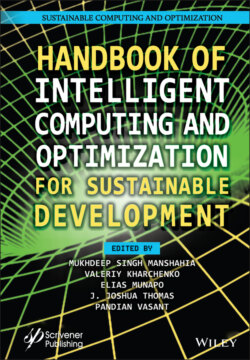Читать книгу Handbook of Intelligent Computing and Optimization for Sustainable Development - Группа авторов - Страница 116
5
Application of Machine Learning Framework for Next-Generation Wireless Networks: Challenges and Case Studies
ОглавлениеSatyendra Singh Yadav1, Shrishail Hiremath2*, Pravallika Surisetti2, Vijay Kumar3 and Sarat Kumar Patra4
1Department of ECE, National Institute of Technology Meghalaya, Meghalaya, India
2Department of ECE, National Institute of Technology Rourkela, Odisha, India
3Centre for Nano Science and Engineering, Indian Institute of Science, Bangalore, India
4Indian Institute of Information Technology Vadodara, Gujarat, India
Abstract
Wireless communication has become an indispensable part of today’s life. Rapid growth in information and communication technologies (ICTs) along with advances in high-performance computing has witnessed a proliferation of efficient parallel and distributed computing algorithms. Presence of these with cloud computing platforms has provided a strong ecosystem for machine learning (ML) and deep learning (DL) techniques. These help to solve many of the problems like classification, optimization, and estimation, to name a few. This chapter highlights trends in fifth-generation (5G) wireless communication and beyond. This chapter further discusses use of ML algorithms in future wireless networks. These studies are expected to provide possible solutions to major challenges in the current and forthcoming wireless technology. 5G system is also expected to provide a foundation for intelligent wireless networks to handle converged applications. ML-based signal processing algorithms have the potential to solve network issues with 5G networks, thereby paving the way to the development of beyond 5G (B5G) intelligent wireless networks. This chapter presents a unified application of data science for wireless communication and analyzes the physical layer challenges for automatic modulation classification (AMC), resource allocation, channel estimation, and millimeter wave communication. Further case studies have been carried out on AMC and channel state information (CSI) feedback in massive multi-input and multi-output (MIMO) systems. The performance of the proposed DL methods has been presented through extensive simulation results.
Keywords: 5G, beyond 5G, wireless communication, machine learning, modulation classification, MIMO, data science
